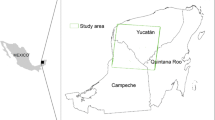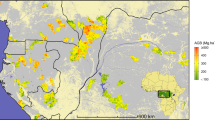Abstract
We used remote-sensing-driven models to detect land-cover change effects on forest aboveground biomass (AGB) density (Mg·ha−1, dry weight) and total AGB (Tg) in Minnesota, Wisconsin, and Michigan USA, between the years 1992–2001, and conducted an evaluation of the approach. Inputs included remotely-sensed 1992 reflectance data and land-cover map (University of Maryland) from Advanced Very High Resolution Radiometer (AVHRR) and 2001 products from Moderate Resolution Imaging Spectroradiometer (MODIS) at 1-km resolution for the region; and 30-m resolution land-cover maps from the National Land Cover Data (NLCD) for a subarea to conduct nine simulations to address our questions. Sensitivity analysis showed that (1) AVHRR data tended to underestimate AGB density by 11%, on average, compared to that estimated using MODIS data; (2) regional mean AGB density increased slightly from 124 (1992) to 126 Mg ha−1 (2001) by 1.6%; (3) a substantial decrease in total forest AGB across the region was detected, from 2,507 (1992) to 1,961 Tg (2001), an annual rate of −2.4%; and (4) in the subarea, while NLCD-based estimates suggested a 26% decrease in total AGB from 1992 to 2001, AVHRR/MODIS-based estimates indicated a 36% increase. The major source of uncertainty in change detection of total forest AGB over large areas was due to area differences from using land-cover maps produced by different sources. Scaling up 30-m land-cover map to 1-km resolution caused a mean difference of 8% (in absolute value) in forest area estimates at the county-level ranging from 0 to 17% within a 95% confidence interval.
Similar content being viewed by others
References
Alexandridis, T., & Chemin, Y. (2002). Landsat ETM+, Terra MODIS and NOAA AVHRR: Issues of scale and inter-dependency regarding land parameters. In: Proceedings of Asian Conference on Remote Sensing, 25–29 November, Kathmandu, Nepal.
Bechtold, W. A., & Patterson, P. L. (2005). The enhanced forest inventory and analysis program—national sampling design and estimation procedures. Gen. Tech. Rep. SRS-80, USDA Forest Service Southern Research Station, Asheville, NC, p 85.
Carleton, T. J. (2003). Old growth in the Great Lakes forest. Environment Reviews, 11, S115–S134.
Chaplin, S., Perera, A., Robinson, S., Adams, J. Gray, T., Whelan-Enns, G., et al. (2001). Western Great Lakes forests (NA0416). Retrieved from http://www.worldwildlife.org/wildworld/profiles/terrestrial/na/na0416_full.html.
Cole, K. L., Stearns, F., Guntenspergen, G., Davis, M. B., & Walker, K. (2003). Historical landcover changes in the Great Lakes Region. Retrieved from http://biology.usgs.gov/luhna/chap6.html.
Dale, V. H. (1997). The relationship between land-use change and climate change. Ecological Applications, 7, 753–769.
DeFries, R. S., & Townshend, J. R. G. (1994). Global land cover: comparison of ground-based data set to classification with AVHRR data. In G. M. Foody, & P. Curran (Eds.) Environmental remote sensing from regional to global scales. Chichester: Wiley.
Dixon, R. K., Brown, S., Houghton, R. A., Solomon, A. M., Trexler, M. C., & Wisniewski, J. (1994). Carbon pools and flux of global forest ecosystems. Science, 63, 185–190.
Drake, J. B., Dubayah, R. O., Knox, R. G., Clark, D. B., & Blair, J. B. (2002). Sensitivity of large-footprint lidar to canopy structure and biomass in a neotropical rainforest. Remote Sensing of Environment, 81, 378–392.
ESRI. (2006). Retrieved December 19, 2006, from http://webhelp.esri.com/arcgisdesktop/9.2/index.cfm?TopicName=BlockMajority.
Friedl, M. A., McIver, D. K., Hodges, J. C. F., Zhang, X., Muchoney, D., & Strahler, A. H., et al. (2002). Global land cover from MODIS: Algorithms and early results. Remote Sensing of Environment, 83, 135–148.
Hame, T., Salli, A., Andersson, K., & Lohi, A. (1997). A new methodology for the estimation of biomass of conifer dominated boreal forest using NOAA AVHRR data. International Journal of Remote Sensing, 18, 3211–3243.
Hansen, M. C., Defries, R. S., Townshend, J. R., & Sohlberg, R. (2000). Global land cover classification at 1 km spatial resolution using a classification tree approach. International Journal of Remote Sensing, 21, 1331–1364.
Heath, L. S., & Birdsey, R. A. (1993). Carbon trends of productive temperate forests of the conterminous United States. Water, Air, and Soil Pollution, 70, 279–293.
Houghton, R. A. (1995). Land-use change and the carbon cycle. Global Change Biology, 1, 275–287.
Houghton, R. A., Hobbie, J. E., Melillo, J. M., Moore, B., Peterson, B. J., & Shaver, G. R., et al. (1983). Changes in the carbon content of terrestrial biota and soils between 1860 and 1980: A net release of CO2 to the atmosphere. Ecological Monographs, 53, 235–262.
Jenkins, J. C., Chojnacky, D. C., Heath, L. S., & Birdsey, R. A. (2004). Comprehensive database of diameter-based biomass regressions for north American tree species. Gen. Tech. Rep. NE-319, USDA Forest Service, Northeastern Research Station, Newtown Square, PA 19073, p. 45.
Justice, C. O., Holben, B. N., & Gwynne, M. D. (1986). Monitoring East African vegetation using AVHRR data. International Journal of Remote Sensing, 7, 1453–1474.
King, M. D., Kaufman, Y. J., Menzel, W. P., & Tanre, D. (1992). Remote sensing of cloud aerosol and water vapor properties from the Moderate Resolution Imaging Spectrometer. I.E.E.E. Transactions on Geoscience and Remote Sensing, 30, 7–27.
Lefsky, M. A., Cohen, W. B., Harding, D. J., Parker, G. G., Acker, S. A., & Gower, S. T. (2002). Lidar remote sensing of above-ground biomass in three biomes. Global Ecology and Biogeography, 11, 393–399.
Lefsky, M. A., Harding, D., Cohen, W. B., Parker, G., & Shugart, H. H. (1999). Surface lidar remote sensing of basal area and biomass in deciduous forests of eastern Maryland, USA. Remote Sensing of Environment, 67, 83–98.
LP DAAC. (2006). Retrieved August 5, 2006, from http://lpdaac.usgs.gov/modis/mod12q1v4.asp.
Malingreau, J.-P., Stevens, G., & Fellows, C. (1985). 1982–83 forest fires of Kalimantan and North Borneo: satellite observations for detection and monitoring. Ambio, 14, 314–346.
McGarical, K., & Marks, B. J. (1995). FRAGSTATS: spatial pattern analysis program for quantifying landscape structure (version 2.0). USDA Forest Service, PNW-GTR-351, Portland, OR.
MRLC. (2006). Retrieved November 14, 2006, from http://www.mrlc.gov/.
National Association of Conservation Districts. (2007). Biomass & Forest Health Update. Retrieved March 15, 2007, from http://forestry.nacdnet.org/forestrynotes/Sep05/SpecialUpdate.htm.
Nemani, R. R., & Running, S. W. (1989). Estimation of regional surface resistance to evapotranspiration from NDVI and thermal-IR AVHRR data. Journal of Applied meteorology, 28, 276–284.
Prince, S. D., & Goward, S. N. (1995). Global primary production: a remote sensing approach. Journal of Biogeography, 22, 815–835.
Ramankutty, N., & Foley, J. A. (1999). Estimating historical changes in land cover: North American croplands from 1850 to 1992. Global Ecology and Biogeography, 8, 381–396.
Richards, J. F. (1990). Land transformation. In B. L. Turner, W. C. Clark, R. W. Kates, J. F. Richards, J. T. Mathews, & W. B. Meyer (Eds.) The earth as transformed by human action: global and regional changes in the biosphere over the past 300 years (pp. 163–178). Cambridge, UK: Cambridge University Press.
Running, S. W., Justice, C. O., Salomonson, V., Hall, D., Barker, J., & Kaufmann, Y. J., et al. (1994). Terrestrial remote sensing science and algorithms for EOS/MODIS. International Journal of Remote Sensing, 15, 3587–3620.
Sader, S. A., Waide, R. B., Lawrence, W. T., & Joyce, A. T. (1989). Tropical forest biomass and successional age class relationships to a vegetation index derived from Landsat TM data. Remote Sensing of Environment, 28, 143–156.
Sannier, C. A. D., Taylor, J. C., & Plessis, W. D. (2002). Real-time monitoring of vegetation biomass with NOAA-AVHRR in Etosha National Park, Namibia, for a fire risk assessment. International Journal of Remote Sensing, 23, 71–89.
Schimel, D. S. (1995). Terrestrial ecosystems and the carbon cycle. Global Change Biology, 1, 77–91.
Schulte, L. A., Crow, T. R., Vissage, J., & Cleland, D. (2003). Seventy years of forest change in the northern Great Lake Region, USA. In L. J. Buse, & A. H. Perera (Eds.) Comps. meeting emerging ecological, economic, and social challenges in the Great Lakes region: Popular summaries (pp. 99–101). Sault Ste. Marie, Ontario, Canada: Ontario Forest Research Institute.
Steininger, M. K. (2000). Satellite estimation of tropical secondary forest above-ground biomass: data from Brazil and Bolivia. International Journal of Remote Sensing, 21, 1139–1157.
Townshend, J. R. G., Justice, C. O., & Kalb, V. T. (1987). Characterization and classification of South American land cover types using satellite data. International Journal of Remote Sensing, 8, 1189–1207.
Tucker, C. J., Gaitlin, J. A., & Schneider, S. R. (1984). Monitoring vegetation in the Nile Delta with NOAA-6 and NOAA-7 AVHRR imagery. Photogrammetric Engineering and Remote Sensing, 50, 53–61.
Tucker, C. J., Townshend, J. R. G., & Goff, T. E. (1985). African land-cover classification using satellite data. Science, 227, 369–375.
Turner, D. P., Koerper, G. J., Gucinski, H., Peterson, C. J., & Dixon, R. K. (1993). Monitoring global change: comparison of forest cover estimates using remote sensing and inventory approaches. Environmental Monitoring and Assessment, 26, 295–305.
USDA Forest Service. (2006). FIA Data Mart: Download Files. Retrieved September 28, 2006, from http://www.ncrs2.fs.fed.us/FIADatamart/fiadatamart.aspx.
USGS. Earth Resources Observation and Science (2006). Retrieved October 19, 2006, from http://edc.usgs.gov/products/satellite/avhrr.html.
USGS-NASA. LP DAAC (2006). Retrieved August 25, 2006, from http://lpdaac.usgs.gov/main.asp.
Zhan, X., Sohlberg, R. A., Townshend, J. R. G., DiMiceli, C., Carroll, M. L., & Eastman, J. C., et al. (2002). Detection of land cover changes using MODIS 250 m data. Remote Sensing of Environment, 83, 336–350.
Zheng, D., Chen, J., Noormets, A., Euskirchen, E. S., & Le Moine, J. M. (2005). Effects of climate and land use on landscape soil respiration in northern Wisconsin, USA: 1972 to 2001. Climate Research, 28, 163–173.
Zheng, D., Heath, L. S., & Ducey, M. J. (2007). Forest biomass estimated from MODIS and FIA data in the Lake States: MN, WI, and MI, USA. Forestry, DOI 10.1093/forestry/cpm015.
Zheng, D., Rademacher, J., Chen, J., Crow, T., Bresee, M., & LeMoine, J. (2004). Estimating aboveground biomass using Landsat 7 ETM+ data across a managed landscape in northern Wisconsin, USA. Remote Sensing of Environment, 93, 402–411.
Author information
Authors and Affiliations
Corresponding author
Rights and permissions
About this article
Cite this article
Zheng, D., Heath, L.S. & Ducey, M.J. Satellite detection of land-use change and effects on regional forest aboveground biomass estimates. Environ Monit Assess 144, 67–79 (2008). https://doi.org/10.1007/s10661-007-9946-1
Received:
Accepted:
Published:
Issue Date:
DOI: https://doi.org/10.1007/s10661-007-9946-1




